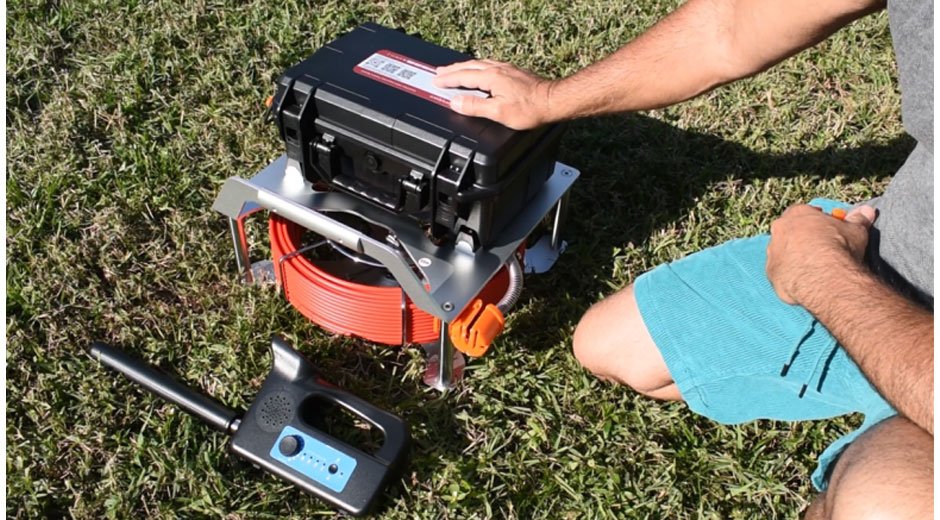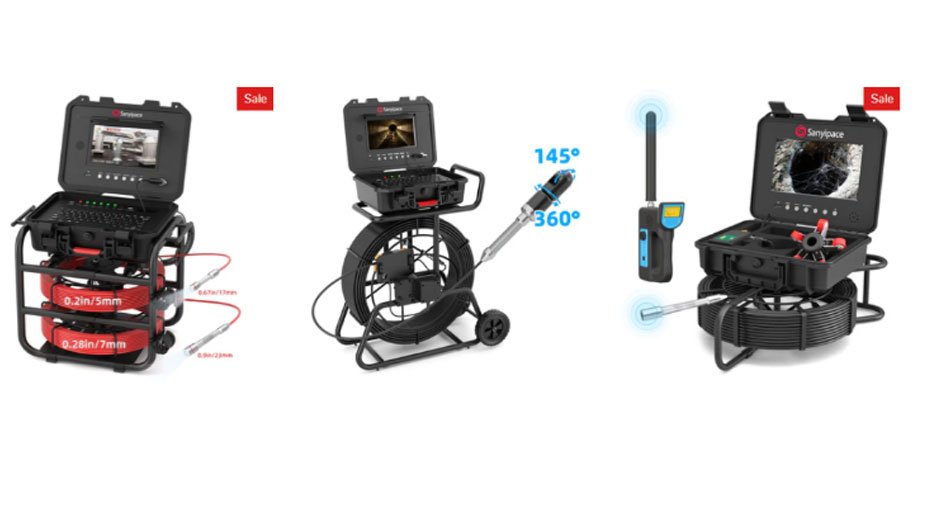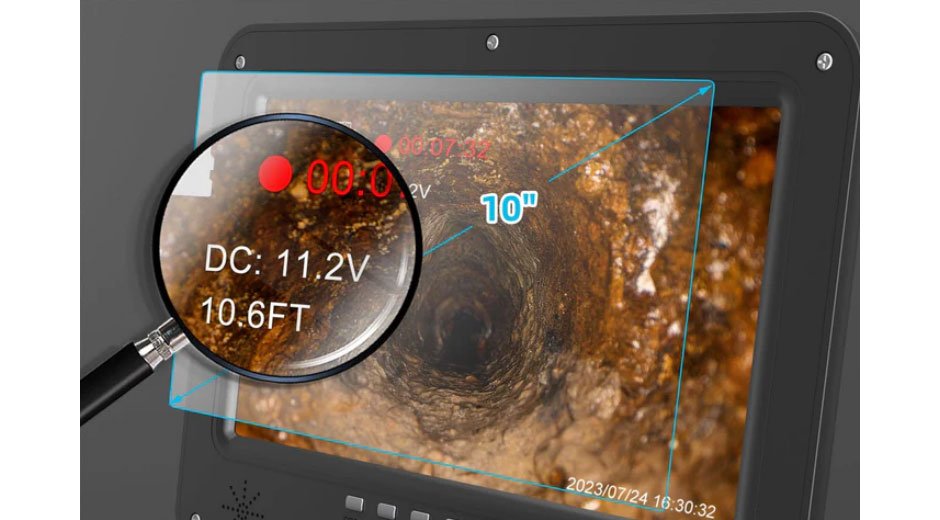Skip to the good bit
ToggleThe shooting distance of a sewer inspection camera can vary depending on the type, model, cable quality, and other equipment configurations.
In this article, we’ll explore how far sewer cameras can actually reach and take a closer look at the measuring ranges of different types of systems.
What Is the Shooting Range of a Sewer Camera?
Most standard sewer cameras can reach anywhere from 100 feet to 300 feet into a pipe system. Entry-level models for homeowners often feature cable lengths of 65–100 feet, while professional-grade units used by plumbers or contractors may offer cable lengths up to 400 or even 500 feet.
However, “shooting range” doesn’t just refer to cable length—it also includes image clarity, signal transmission, and maneuverability. A plumbing camera might technically reach 300 feet, but if the video feed cuts out or becomes blurry past 150 feet, that limits its effective range.
Quick Range Overview:
| Camera Type | Typical Range |
| Entry-Level Models | 65–100 feet |
| Mid-Range Commercial | 150–200 feet |
| Professional Equipment | 300–500+ feet |
What Factors Affect the Shooting Distance of a Sewer Camera?

Several variables can impact how far your sewer camera can shoot effectively:
1. Cable Length and Thickness
The most obvious factor is the cable. Longer cables allow you to inspect deeper pipe systems, but thicker or more rigid cables may be harder to maneuver around sharp bends.
2. Camera Head Size
Smaller cameras are more agile and can travel farther through narrow or curved lines. Larger cameras may get stuck or be restricted by pipe diameter.
3. Pipe Size and Configuration
Tight 90-degree bends, T-junctions, or blockages can dramatically reduce range. A camera may reach only 80 feet in a complex residential setup but 300 feet in a straight municipal main line.
4. Signal Transmission Quality
Wireless transmission systems tend to lose signal after short distances or through dense materials. Wired systems are far more reliable for longer distances.
5. Lighting and Visibility
Low-light performance, typically supported by LED lights, becomes critical the further the camera travels. Poor lighting can shorten your ability to see clearly, even if the camera continues physically moving forward.
6. Camera Type (Push Rod vs. Crawlers)
Push rod cameras are manually fed and usually have a shorter reach. Motorized crawler cameras, often used by municipalities, can go much farther and offer better control in large pipelines.
Types of Sewer Cameras and Their Ranges

Choosing the right sewer camera starts with understanding the different types available and how far each can realistically go. Whether you’re inspecting a 30-foot residential pipe or a 500-foot municipal main line, each camera type offers unique strengths and limitations.
1. Push Rod Sewer Cameras
Push rod cameras are the most widely used sewer inspection tools. They consist of a small camera head attached to the end of a flexible fiberglass cable that’s manually pushed through the pipe. The camera sends a live video feed back to a monitor as it travels.
Typical Range: 65 to 300 feet
Use Case: Most common for residential plumbing inspections, small-scale commercial applications, or DIY troubleshooting.
Pros:
- Affordable and easy to use
- Lightweight and portable
- No external power required
- Works well in smaller diameter pipes (1.5″–4″)
Cons:
- Limited by tight bends and turns
Manual pushing can get difficult over long distances - Less control in direction or orientation
Best For: Homeowners, small plumbing businesses, real estate inspections
2. Self-Leveling Sewer Cameras
These cameras automatically level themselves inside the pipe so that the video feed remains upright no matter how the cable twists.
This feature greatly enhances video review and diagnosis, especially when trying to pinpoint issues like joint offsets or root intrusions.
Typical Range: 100 to 325 feet
Use Case: Ideal for plumbing pros needing consistent orientation for clearer footage during long-distance inspections.
Pros:
- Upright video makes footage easier to interpret
- Available in both rigid and semi-flexible designs
- Enhanced clarity for documentation and reports
- Durable camera heads, often with better lighting
Cons:
- More expensive than standard push rods
- Slightly bulkier due to the leveling mechanism
Best For: Plumbing contractors, municipal inspectors, insurance documentation
3. Crawler Sewer Cameras (Robotic Systems)
Crawler systems are remote-controlled robotic units that drive through the pipeline using motorized wheels or tracks. They are equipped with high-definition cameras (often with zoom and pan/tilt/rotate features), strong lighting, and sometimes even sonar.
Typical Range: 300 to 1,000+ feet
Use Case: Required for large-scale inspections such as municipal sewer lines, storm drains, and industrial pipelines.
Pros:
- Incredible range and maneuverability
- High-definition and multi-angle video recording
- Precision control via handheld remote or tablet
- Can handle large-diameter pipes (6″–60″+)
Cons:
- Very expensive (often $10,000+)
- Requires power source, sometimes even a generator
- Needs a trained operator
Best For: Municipalities, sewer maintenance companies, and environmental engineering teams
4. Portable Reel Sewer Camera Systems
These are push rod systems packed into a portable reel design, often integrated with a compact monitor, recording unit, and rechargeable battery. Some models are backpack-style or come in rugged rolling cases.
Typical Range: 100 to 200 feet
Use Case: Professionals who need to inspect multiple locations quickly without hauling heavy equipment.
Pros:
- All-in-one design (monitor, battery, cable reel)
- Great for quick jobs and on-the-go technicians
- More durable than entry-level models
- Often compatible with Wi-Fi or app control
Cons:
- Still limited by bends and sharp turns
- Some entry models may lack image quality or features
Best For: Mobile plumbing teams, real estate inspectors, property managers
Sewer Camera Type Summary
| Camera Type | Typical Range | Ideal Use Case | Price Range |
| Push Rod | 65–300 ft | Residential pipes, basic inspections | $200–$1,500 |
| Self-Leveling | 100–325 ft | Professional diagnostics & reporting | $800–$3,000 |
| Crawler (Robotic) | 300–1,000+ ft | Municipal and industrial inspections | $10,000+ |
| Portable Reel | 100–200 ft | Mobile inspections across multiple sites | $800–$2,500 |
When You Need More Reach
Sometimes, standard cameras just don’t cut it. Here’s when you should consider upgrading to a long-range sewer inspection camera:
- Inspecting municipal or industrial pipelines(typically 300–1000+ feet)
- Dealing with recurring blockages deep in the line
- Pre-purchase inspections for large properties
- Mapping older sewer systems
- Video recording for legal or insurance purposes
Long-range sewer cameras often include 360° rotating heads, better lighting, and enhanced cable durability. Some also come with footage counters and recording capabilities, allowing you to log the exact location of problems for repairs.
Conclusion
So, how far can a sewer camera shoot? The short answer is anywhere from 65 feet to over 1,000 feet, depending on the model and application. For most residential uses, a 100–200 ft cable is more than sufficient. But if you’re dealing with large-scale inspections, a high-end crawler system with extended reach is the way to go.
Understanding the limitations and strengths of different camera systems will help you make the right decision—whether you’re buying for your business or renting for a one-time job.
Want to See Deeper?
If you’re in the market for a sewer camera with extra reach and clarity, explore high-performance systems like the Sanyipace 525FT Long-Range Sewer Camera with 360° rotation, designed for professionals who need to inspect further and smarter. Visit the Sanyipace inspection camera to learn more.
FAQs
What’s the Maximum Length a Sewer Camera Can Go?
Some professional systems can go over 1,000 feet, especially motorized crawlers used in municipal settings.
Can a Regular Push Camera Inspect a 200-ft pipe?
Yes, many mid-range push cameras can reach up to 200 feet, but effectiveness depends on pipe bends and camera build.
Do Longer Cables Reduce Image Quality?
Not necessarily. High-quality systems use strong signal transmission to maintain image clarity even at long distances.
Is a Longer Camera Always Better?
Not always. Longer cables are heavier and harder to maneuver. It’s best to choose a range suitable for your specific job.







